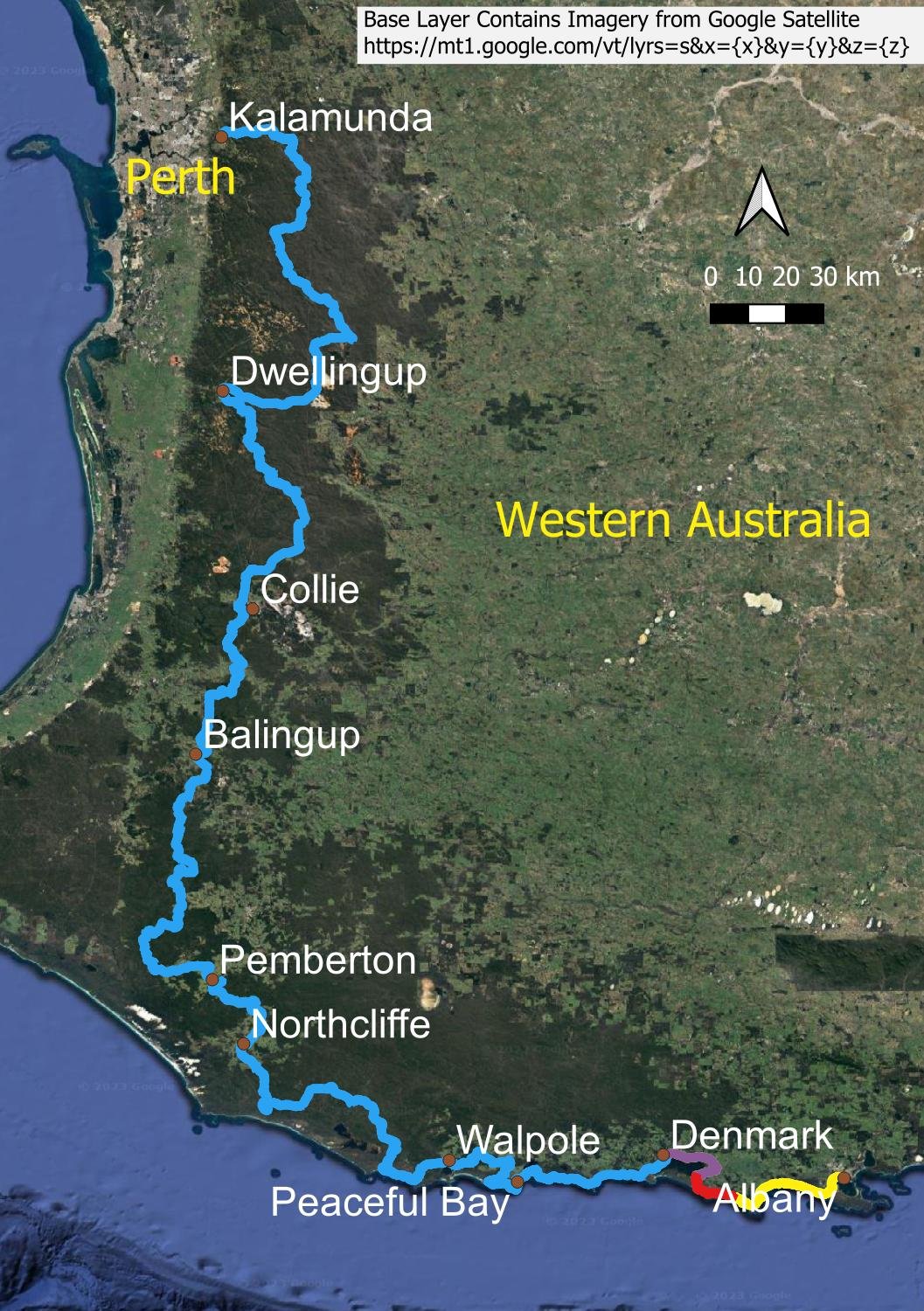Day 69: Denmark to West Cape Howe via Nullaki
We acknowledge the Nyoongar People as the traditional custodians of the land and waters along the Bibbulmun Track
For slower hikers end-to-ending North to South, you will likely be struck with strangely bittersweet emotions: you are nearing the end, the completion of not just the walking but all the other physical and psychological journeys you have undertaken.
Today is filled with stunning coastal scenery but there are also the last of those magnificent inland views to enjoy!
Overview map
Use Bibbulmun Track Foundation Map 8: Denmark/Albany
In this last section, we begin inland but then follow the amazing wild coastline of the great Southern Ocean, passing through swathes of spring wildflowers, white sand beaches and enjoying those last sunsets and moments with Tramily in the huts and on the track.
The day’s details: the track transfer is not included in the elevation graph figures.
The new track along the southwesterly part of the Inlet is not yet finalised — it is now — and hikers were asked not to hike the contested western end, so we have arranged a fun paddle across to the jetty instead. At the last minute, this falls through (you have been warned!); the boat transfer is not available either so we are faced with a long road hike alongside busy highway traffic around the northern part of the inlet. The highway shoulder is narrow so avoid this option if at all possible.
Fortunately, our kind Track Angel comes to the rescue and drops us near the southeastern end of the inlet rather than at the jetty; he tells us this is the usual drop-off spot. This significantly shortens the distance to Nullaki so we re-evaluate; we may continue on past Nullaki Hut to West Cape Howe depending on how the day unfolds. We (especially Helen!) are much more comfortable altering plans than we were at the beginning of our thru-hike: you too will likely find this happens as you deal with the inevitable delays and glitches without any skies falling. You trust your gear and that you have spare food; hotel bookings can be altered, or there’s always a caravan park to pitch the tent. It will be okay.
Almost immediately there is a field of spectacular kangaroo paw (Anigozanthos flavidus). These are pollinated by honeyeaters rather than insects.
We see plenty of orchids, too. Here, Caladenia attigens
And another tiny unknown species.
It is extremely wet with heavy showers interspersed with bursts of bright sunshine. Here we are at Nullaki. It is a lovely hut but it is too early to stop for the day. Time for a snack and a poke around - you’ll find more orchids around the hut.
Lovely sandy campsites, but we are not staying.
Despite the rain, there is enough warmth and scattered sun to partially open Thelymitras, here T. macrophylla
And plenty of Dunsborough Donkeys (Diuris jonesii).
Another shower but the terrain is delightful. The Visp rain gear has lost a little of its waterproofness after numerous days of use without being washed with techwash to restore the DWR, but they are still performing remarkably well. They have survived brushing through soft shrubs (don’t try this in Tassie’s scoparia!); the only repair is a Tenacious Tape patch on the knee of my pants where I came a cropper on gravel near the start of our E2E.
And off with the jacket again as the sun comes out. Another snack on a hiker’s seat. We have both increased our protein intake considerably: Geoff to slow muscle loss (we later learn he has lost 6kg and, as a relatively lean man, much of it has been muscle), and me to build it: I’ve lost fat but not gained muscle.
Views inland. There is a remarkable amount of fresh standing water in the SW of WA; it is noticeably different from SA. You’ll often hear the birdlife when the wind is in the right direction.
More snakes today. Dugites are highly venomous but not aggressive. This big mama takes her time to meander off the track and we are not about to hurry her along! We highly recommend long loose pants and closed shoes, or gaiters if you’re wearing shorts, if you’re hiking the southern sections of the Bibbulmun. You’ll have zero stress about bites if your legs and feet are covered, and will be able to enjoy the snakes you’ll inevitably encounter. It is not uncommon for hikers to see a dozen snakes a day on the track: there are far more than in many other parts of Australia.
A new orchid, Microtis media ssp. densiflora, growing behind the dunes.
Nearing the sea. Just look at those flowers, blue Scaevola and pink Pimelea.
More new orchids, with the temperature just warm enough to open them: Thelymitra benthamiana…
… and its leucistic form, a whole patch of them.
Back into marvellously healthy mallee and banksia
Banksia verticillata
And the violet triggerplant, Stylidium violaceum
Crispy crinkly pure white paper daisies (Rhodanthe sp.) brighten up the already colourful track.
More Caladenia attigens, huge specimens much more brightly coloured than we have seen further west..
Another nicely placed seat from which to enjoy the view. It’s thoughtful little touches like this that really make a track, not just excellent contouring, routing or surfaces.
And of course there are many varied views and vantage points to enjoy… another tiny find!
More showers so I take few pictures, here during a little break between the squalls.
And finally at West Cape Howe hut, in a spot sheltered from the southerlies and tucked amongst the vegetation. I take a few quick snaps, then go to pitch our tent…
… in an equally sheltered little spot. A lot of mosquitoes frequent the huts and in any case we prefer our tent unless it’s actually bucketing down when we are about to pitch.
Pastel evening sunset views to finish the day. So few evenings left!




























